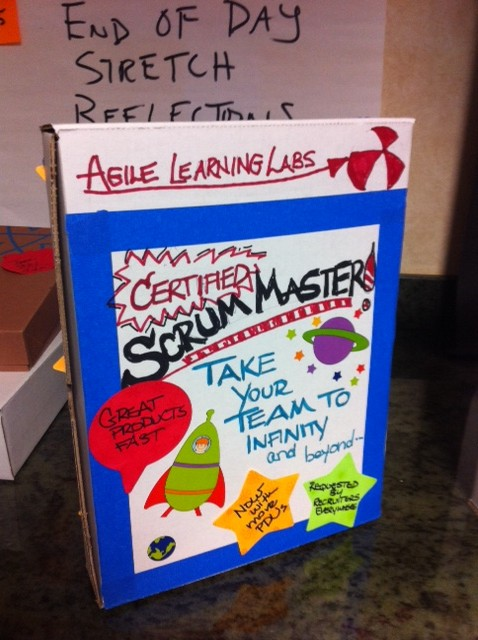Description
What is this technique about
The Product Vision Box is a fun, useful and collaborative tool, typically utilized at the onset of a new project, that enables teams to clearly define, understand and communicate the solutions’ vision in a condensed way. The idea is derived from a typical cereal packaging and tries to reduce to the essential parts of a vision, how a solution should look like.
The front of the box is designed for stakeholders, funders and/or other team members. These elements include:
- The name of the solution
- A visual representation of the solution/project, such as a logo
- A catchy slogan
- 3 to 4 persuasive selling points
By incorporating these elements, the front of the box becomes an eye-catching representation of the future product.
The back of the box is used to present all of the details and requirements of the project. It’s important to highlight the main features, even if there are many of them, in order to keep it concise.
Both sides of the Product Vision Box are important in presenting a complete picture of the solution. Like on a cereal box, the ingredients that make up the future product can be defined: On one side, you all the technical components such as the framework, language, etc. that are necessary to bring the product to life can be listed. On the other side, it is useful to identify the target user demographic by listing personas that would be utilizing the product.
Where does it come from
The Product Vision Box is a very simple yet powerful techniques promoted by James Highsmith (Highsmith, 2004) for inspiring enthusiasm among all stakeholders and helping them align their efforts to a common vision. The basic idea behind the Product Vision Box is to create an actual, physical box that has to be used to market the product. It derives its idea from lean and agile project management. Due to its limited space, one has to focus on the essential parts.
For which purposes it is used (why in your engineering teaching)
A product vision is a compelling image of the final solution that inspires and motivates the entire team to bring it to life. The Product Vision Box represents the product’s objectives, features, and customer value and is used for marketing purposes. It relates to the problem that a solution solves and promotes a product-oriented mindset, enhancing clarity within the development team. The vision provides clear guidance and can be used to prioritizes, accept and reject requirements.
The vision outlines the long-term aspirations for the product on a high level of detail and helps the team understand the bigger picture, serving as the basis for the roadmap. In an agile environment, the product owner is responsible for the vision.
With the presence of a vision, the team is able to stay focused on the critical elements, aligned with the same goal. It allows for a clear understanding of the long-term objective, preventing a narrow focus on short-term goals e.g. in 2–4-week sprints. A well-defined vision minimizes ambiguity and reduces unnecessary debates, especially in projects that involve a high degree of uncertainty.
How to use it
The Product Vision Box method is used after the “ideation & conceptual design” or before the “implementation” phase. The project team responsible for generating the ideas should remain the same during the NABC session, with a maximum of 6-7 students. If the technique is used before an implementation of a solution, the class should be broken down into teams of about 6-7 students.
For this teamwork exercise, around 45 minutes should be planned to make a box per team. If an agile setting is planned, the teams should be able to ask the product owner for details to create their box.
How to implement this techniques online
- Prepare a digital whiteboard for the front, back and sides of the box.
- Define the equivalent space for all sides of the box as they are on a physical cereal box.
During application, i.e., while giving the session
- Introduce the exercise and its purpose, especially the contents of the front side.
- Let the students do a teamwork for around 45 minutes.
- For feedback and evaluation, let all teams present their Product Vision Box in the plenum within a maximum of 5 minutes.
Follow-up, about what to do after the session
- Debrief and wrap up, e.g. let each group or team present their scenarios.
- Store the whiteboard.
- The scenarios typically contain lots of requirements for the solution. It may be useful to extract these requirements for the detailed design and implementation phases.
Examples and/or testimonials
Prof. Dr. Christoph Kunz uses this technique in his course “Agile and hybrid project management for digital product development”. In this, groups of 4-5 students have to develop a project vision for a given project task.
Example Product Vision Box for “Scrum Master” as a product:

Tools needed
You will need a platform to share screens and communicate with the participants, such as: MS Teams, Zoom or similar. You will also need a white board solution with digital sticky notes such as Miro or Mural:
- Zoom
- MS Teams
- Miro
- Mural
- Timer (phone, watch, computer)
Resources
Links
Adobe Systems Software Ireland Ltd. (2023). Box Template Bilder. Available at: https://stock.adobe.com/de/search?k=box+template
Videos
Simon Girvan. (2020, April 30). Launching Agile Projects 4 The Product Box. [Video]. YouTube. Available at: https://youtu.be/JieIp70DlRA
Graphic Designer PRO. (2020, April 02). Product Box Mockup Tutorial • Photoshop & Illustrator Tutorial. [Video]. YouTube. Available at: https://youtu.be/5fvE4SPmWp0
Paper
Highsmith, J. (2004): Agile Project Management: Creating Innovative Products. Addison-Wesley.